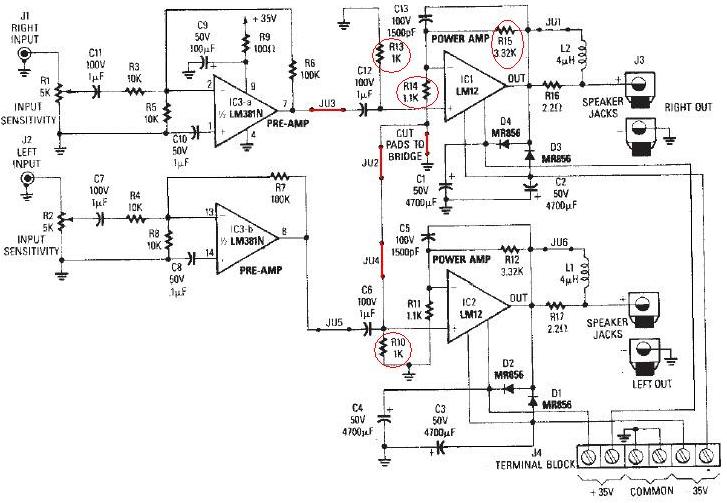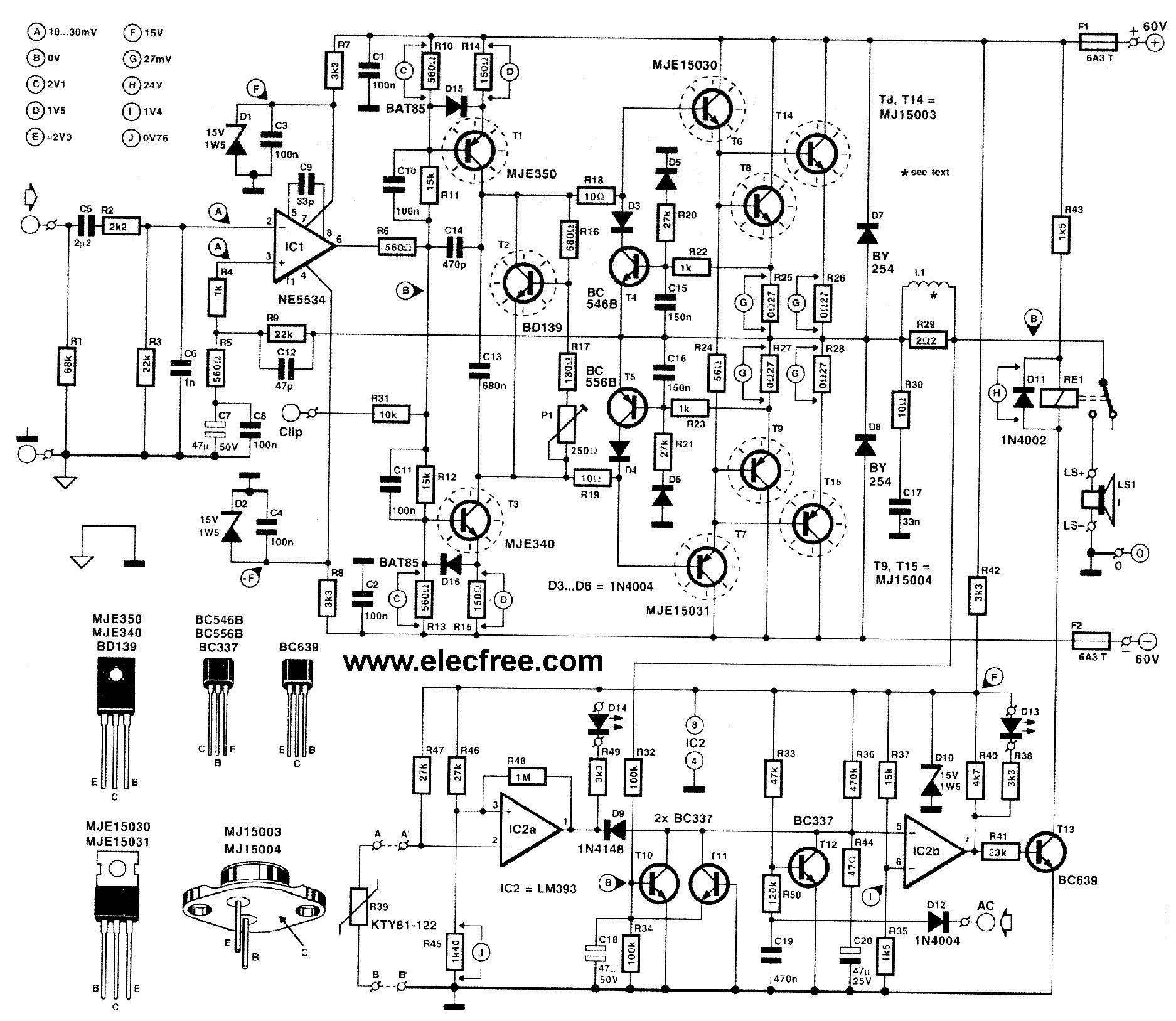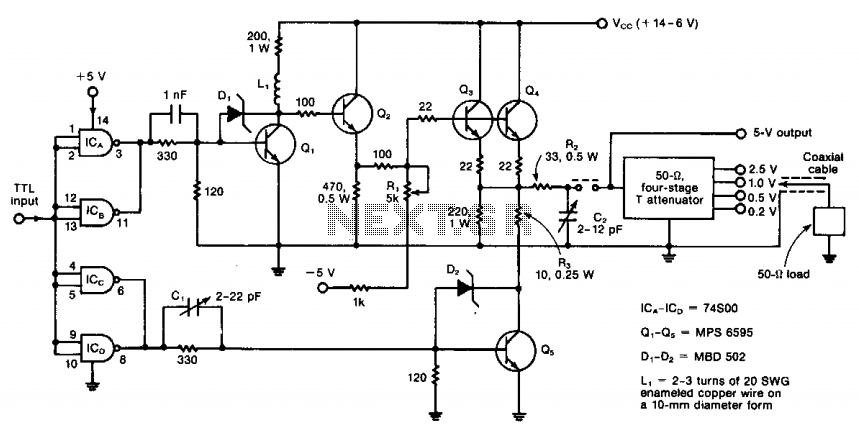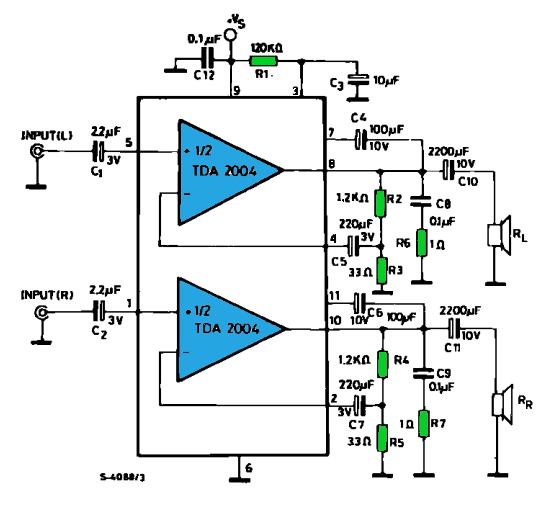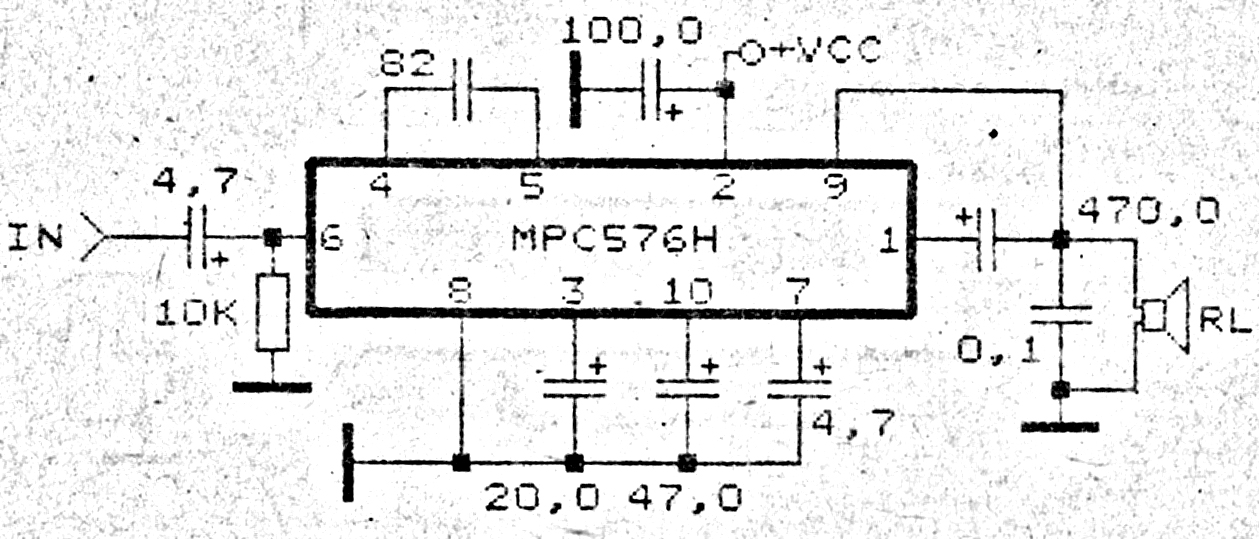
Amplifier Stages
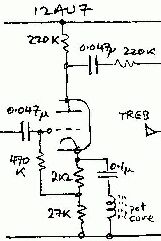
The XLR or Cannon-type connector is a superior audio connector compared to a 6.5mm jack plug and socket. However, tradition mandates the use of the 6.5mm socket, despite its significant connection issues. Inputs can vary from a single socket directly connected to the grid of the first stage, without resistors or blocking capacitors (as seen in Marshall PA), to configurations with up to six inputs (like the Vox AC-30 II), each differing in design. When using the upper socket, the input has a resistance of 1M to ground and two 68k resistors in parallel, resulting in 34k in series. The lower input features two 68k resistors in series, totaling 136k, which halves the input signal (-6dB). The cathode bypass capacitor on the lead channel is set to a lower value of 0.67 μF, introducing more AC negative feedback across the 2.7k resistor at lower frequencies, leading to a brighter or "toppy" channel. Outputs are mixed downstream. Ideally, the common connection of the socket should be isolated from the chassis to avoid ground loops; however, commonly available isolated sockets are often not robust enough for guitar inputs. Although XLR connectors are more durable, they typically lack switch contacts. Simple amplifiers usually contain only one amplifier channel, even if they have multiple input sockets. Different signals are mixed early in the signal chain and amplified together. More complex amplifiers often feature two or more channels, typically one unaffected channel with its own tone and volume controls and another affected channel with controls for effects such as reverb and tremolo/vibrato. These channels are then mixed into the main power amplifier. Channel switching can be implemented in a valve amplifier if desired, but it is crucial to have a clear indicator showing which channel is selected. Anode and cathode resistors usually range from 100k and 1.5k to 220k and 2.2k, always paired with a 25μF/25V bypass capacitor. This choice may not be optimal, as they typically operate at around 2 volts. Although failures are uncommon, the bypassing of audio may not be performing at its best. A voltage rating closer to the operating voltage could provide advantages. As a general rule, electrolytic capacitors should operate above half their rated voltage to ensure proper formation. The value tolerance of typical electrolytic capacitors from that era, such as those from Elna, was -50%/+100%. The EF86 shown is a specific low-noise front-end amplifier, though other pentodes like the 6AU6 have also been utilized. A pentode offers significantly greater voltage gain compared to a single triode stage, achieving gains of approximately x200 versus x50. The grounding in these stages utilized a single-point system, with all ground returns connected to a common point near the valve base, sometimes represented by a metal cylinder at the center of the valve base. Octal sockets occasionally featured four grounding lugs integrated into the base mounting ring, although they were generally less effective, particularly at radio frequencies (RF). The high-tension (HT) supply should also follow a single-point grounding scheme, with the two ends of the 24μF bypass capacitor serving as the common points, ideally shorted together for AC by the capacitor. In public address (PA) microphone preamp applications, these components were sometimes mounted on a sub-chassis within cages or boxes, insulated with rubber grommet shock mounts to mitigate microphony. Preamp valves are susceptible to microphonics, radio frequency rectification, capacitive pickup, and magnetic pickup, necessitating the installation of shielding cans. These shielding solutions can range from simple aluminum curls with wire clip retainers to more sophisticated blackened steel designs with internal seating springs and copper heat transfer fingers. The two most common shielding forms include: i) a twist-lock mechanism resembling an inside-out light globe bayonet connector, and ii) a snap-on design featuring a constriction at the bottom that securely attaches over a matching rib.
The design and implementation of audio connectors and amplifiers require careful consideration of various electrical parameters and physical characteristics. The use of XLR connectors, while more durable, necessitates an understanding of their limitations, particularly regarding switch contacts essential for channel selection. The input resistance configurations in amplifiers influence the overall audio quality and tonal characteristics, necessitating precise calculations and component selections to achieve desired outcomes. The integration of bypass capacitors and their voltage ratings plays a critical role in the performance of audio circuits, as improper ratings can lead to inefficiencies and potential failures. Additionally, grounding techniques, particularly in valve amplifiers, must be meticulously planned to prevent interference and ensure optimal signal integrity. The choice of shielding for preamp valves is equally important, as it protects against unwanted noise and enhances the reliability of the amplifier's performance. Overall, a comprehensive understanding of these elements is vital for the effective design and operation of audio equipment.The XLR or Cannon-type connector is clearly a better audio connector than a 6. 5mm jack plug and socket, but tradition makes the 6. 5mm socket mandatory despite its serious connection problems. Inputs range from a single socket connected directly to the grid of the first stage, no resistors or blocking cap (Marshall PA); and up to six ( Vox AC-30 II), all different. When the input is plugged into the upper socket the input has 1M to ground and two 68k in parallel, 34k, in series. In the lower input the input resistance is two 68k in series, 136k, and divides the input in half (-6dB). The cathode bypass capacitor on the lead channel is much lower value, 0. 67 uF, causing more AC negative feedback across the 2k7 at lower frequencies, so producing a `toppy` channel.
The outputs are mixed downstream. Ideally the common of the socket should be isolated from the chassis to prevent earth loops. Commonly available isolated sockets are not nearly robust enough for guitar input service. XLR`s are tougher, but they don`t come with switch contacts. Simple amps have only one amplifier channel even when they have a lot of input sockets. Different signals are mixed early in the chain and amplified together. More complex amplifiers provide two or more channels. Normally they were an un-effected channel with its own tone and volume controls; and an effected channel with its own controls including reverb and tremolo/vibrato. These were then mixed into the main power amplifier. There is no reason why channel switching cannot be applied to a valve amp if desired, but it is important to have an `at-a-glance` indicator to show you which channel is selected.
The anode and cathode resistors are typically 100k and 1k5 as shown, or 220k and 2k2, always with a 25uF/25V bypass. This was not a great choice since they only have around 2 volts on them in operation. Failures may be rare but they may not be bypassing audio to their best either. There may be some benefit from using a voltage rating closer to the actual operating voltage. As a rule of thumb electros should operate at more than half their rated voltage so they `form up` correctly.
The value tolerance on typical electros of the era, for example Elna, was -50%/+100%. The EF86 shown here was a specific low-noise front-end amp, but other pentodes such as the 6AU6 have been used. A pentode provides considerably more voltage gain than a single triode stage e. g. x200 against x50. The single-point earth was literal with these stages, all earth returns brought back to a single common point near the valve base, sometimes a metal cylinder in the middle of the valve base.
Octal sockets sometimes had four inviting grounding lugs formed into the base mounting ring with the same general idea, but generally not as effective (particuarly at RF). The HT supply should mirror the grounding and should also be single-point, the two ends of the 24uF bypass cap being the two common points, hopefully shorted together to AC by the cap.
In PA mic preamp service these were sometimes mounted on a sub-chassis, in cages and sometimes boxes, floating and insulated with rubber grommet shock mounts to prevent microphony. Preamp valves are prone to microphonics, Radio Frequency rectification, capacitive pickup, and magnetic pickup, so are normally fitted with some form of shielding can.
This ranges from a simple curl of aluminium with a wire clip retainer, to lock-down blackened steel with internal seating spring and copper heat transfer fingers. The two most common forms are i) a twist-lock like an inside-out lightglobe bayonet connector, and ii) a snap-on form with a constriction around the bottom that snaps over a matching rib
🔗 External reference
The design and implementation of audio connectors and amplifiers require careful consideration of various electrical parameters and physical characteristics. The use of XLR connectors, while more durable, necessitates an understanding of their limitations, particularly regarding switch contacts essential for channel selection. The input resistance configurations in amplifiers influence the overall audio quality and tonal characteristics, necessitating precise calculations and component selections to achieve desired outcomes. The integration of bypass capacitors and their voltage ratings plays a critical role in the performance of audio circuits, as improper ratings can lead to inefficiencies and potential failures. Additionally, grounding techniques, particularly in valve amplifiers, must be meticulously planned to prevent interference and ensure optimal signal integrity. The choice of shielding for preamp valves is equally important, as it protects against unwanted noise and enhances the reliability of the amplifier's performance. Overall, a comprehensive understanding of these elements is vital for the effective design and operation of audio equipment.The XLR or Cannon-type connector is clearly a better audio connector than a 6. 5mm jack plug and socket, but tradition makes the 6. 5mm socket mandatory despite its serious connection problems. Inputs range from a single socket connected directly to the grid of the first stage, no resistors or blocking cap (Marshall PA); and up to six ( Vox AC-30 II), all different. When the input is plugged into the upper socket the input has 1M to ground and two 68k in parallel, 34k, in series. In the lower input the input resistance is two 68k in series, 136k, and divides the input in half (-6dB). The cathode bypass capacitor on the lead channel is much lower value, 0. 67 uF, causing more AC negative feedback across the 2k7 at lower frequencies, so producing a `toppy` channel.
The outputs are mixed downstream. Ideally the common of the socket should be isolated from the chassis to prevent earth loops. Commonly available isolated sockets are not nearly robust enough for guitar input service. XLR`s are tougher, but they don`t come with switch contacts. Simple amps have only one amplifier channel even when they have a lot of input sockets. Different signals are mixed early in the chain and amplified together. More complex amplifiers provide two or more channels. Normally they were an un-effected channel with its own tone and volume controls; and an effected channel with its own controls including reverb and tremolo/vibrato. These were then mixed into the main power amplifier. There is no reason why channel switching cannot be applied to a valve amp if desired, but it is important to have an `at-a-glance` indicator to show you which channel is selected.
The anode and cathode resistors are typically 100k and 1k5 as shown, or 220k and 2k2, always with a 25uF/25V bypass. This was not a great choice since they only have around 2 volts on them in operation. Failures may be rare but they may not be bypassing audio to their best either. There may be some benefit from using a voltage rating closer to the actual operating voltage. As a rule of thumb electros should operate at more than half their rated voltage so they `form up` correctly.
The value tolerance on typical electros of the era, for example Elna, was -50%/+100%. The EF86 shown here was a specific low-noise front-end amp, but other pentodes such as the 6AU6 have been used. A pentode provides considerably more voltage gain than a single triode stage e. g. x200 against x50. The single-point earth was literal with these stages, all earth returns brought back to a single common point near the valve base, sometimes a metal cylinder in the middle of the valve base.
Octal sockets sometimes had four inviting grounding lugs formed into the base mounting ring with the same general idea, but generally not as effective (particuarly at RF). The HT supply should mirror the grounding and should also be single-point, the two ends of the 24uF bypass cap being the two common points, hopefully shorted together to AC by the cap.
In PA mic preamp service these were sometimes mounted on a sub-chassis, in cages and sometimes boxes, floating and insulated with rubber grommet shock mounts to prevent microphony. Preamp valves are prone to microphonics, Radio Frequency rectification, capacitive pickup, and magnetic pickup, so are normally fitted with some form of shielding can.
This ranges from a simple curl of aluminium with a wire clip retainer, to lock-down blackened steel with internal seating spring and copper heat transfer fingers. The two most common forms are i) a twist-lock like an inside-out lightglobe bayonet connector, and ii) a snap-on form with a constriction around the bottom that snaps over a matching rib
🔗 External reference
